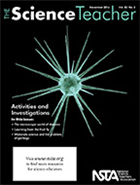The Green Room: Losing Sight of Our Stars
By sstuckey
Posted on 2016-11-16
Making Your Teaching More Environmentally Friendly
The more people there are, the more lights we use. The more lights we use to illuminate our buildings and streets, the brighter the Earth becomes at night.
Author David Owen discussed the increase in this light pollution over the past 50 years in a 2007 New Yorker article. “The stars have not become dimmer; rather, the Earth has become vastly brighter, so that celestial objects are harder to see. Air pollution has made the atmosphere less transparent and more reflective, and high levels of terrestrial illumination have washed out the stars overhead—a phenomenon called ‘sky glow’” (Owen 2007).
Many resources can help inform your students about light pollution. The United Kingdom’s Telegraph newspaper has a gallery of images. James Madison University (JMU) professor Paul Bogard details in a book (2013) the environmental and human health effects of light pollution and the importance of darkness. The John C. Wells Planetarium on the JMU campus provides supplemental information, including a video, on its website.
Various organizations and municipalities are working to minimize light pollution sources. For instance, the International Dark-Sky Association (IDA) “works to protect the night skies for present and future generations,” offering information and a video online. Another group, Dark Skies, Inc., was recently featured in the New York Times for its efforts to reduce light pollution in Colorado (Healy 2016).
Classroom activities
Light pollution is an interesting topic for students. You can lead an evening field trip of star-gazing, but there are other options, too. The resource guide from the Astronomical Society of the Pacific has links to many books, articles, websites, and activities dedicated to light pollution. Some of the activities come from Globe at Night, an organization which raises awareness of light pollution and encourages people to measure their local night-sky brightness.
In addition, your students can manipulate a global light pollution map online by adding layers and exploring any location on Earth. From the American Museum of Natural History comes the “Light Pollution: Beyond the Glare” activity in which students watch an introductory video and complete a graphic organizer. Taking at least 50 minutes of class time is PBS’s “Which Way to the Ocean?” lesson plan. Using clips from the 2012 PBS film The City Dark, this thorough activity demonstrates the effects of light pollution on nesting loggerhead turtles.
Finally, the National Optical Astronomy Observatory (NOAO) produced a series of activities about light and light pollution in 2015, the International Year of Light. Pick and choose among all of the options on the NOAO website.
Amanda Beckrich (aabeckrich@gmail.com) is the Upper School assistant director, International Baccalaureate (IB) diploma program coordinator, and an environmental science teacher at Christ Church Episcopal School in Greenville, South Carolina.
References
Bogard, P. 2013. The end of night: Searching for natural darkness in an age of artificial light. Boston: Little Brown and Company.
Healy, J. New York Times. 2016. Colorado Towns Work to Preserve a Diminishing Resource: Darkness. August 12.
http://nyti.ms/2bnIAdQ
Owen, D. The New Yorker. 2007. The dark side: Making war with light pollution. August 20. http://bit.ly/2btPuxr
Editor’s Note
This article was originally published in the November 2016 issue of The  Science Teacher journal from the National Science Teachers Association (NSTA).
Science Teacher journal from the National Science Teachers Association (NSTA).
Get Involved With NSTA!
Join NSTA today and receive The Science Teacher,
the peer-reviewed journal just for high school teachers; to write for the journal, see our Author Guidelines, Call for Papers, and annotated sample manuscript; connect on the high school level science teaching list (members can sign up on the list server); or consider joining your peers at future NSTA conferences.
Disclaimer: The views expressed in this blog post are those of the author(s) and do not necessarily reflect the official position of the National Science Teaching Association (NSTA).



